If you are an architecture firm, you might be thinking about the best way to approach content marketing. Especially in order to get your architecture website ranking for key phrases on major search engines like Google.
However, you might be unsure where to begin or which content strategies are the most effective. If this is the case, then you are not alone.
Ultimately, the key problem with content marketing is ensuring you’re not wasting time or effort creating content which doesn’t perform.
With so many ways to promote your business online, it can be hard to understand what is important. So, as an architecture firm, what content strategies do you prioritise?
Learn From the Best Content Marketers in Your Industry

Rather than start from scratch, we think it is smarter to apply the principles from the best. Then, adapt these strategies to align with your architecture firm’s goals.
Fortunately, we’ve already analysed the top examples of content marketing by architecture firms. So we can help you to understand what is currently working and inspire you to start creating your own content.
But whilst examples are helpful, how do you ensure that your firm doesn’t make content marketing mistakes along the way?
We think it’s also useful to understand the key considerations facing architecture firms. Especially when it comes to approaching their own content marketing.
With this in mind, we have put together 14 content lessons for architecture firms.
These content marketing lessons for architecture firms were taken from the very best firms. Following these lessons will help your architecture firm make the jump into content marketing seamless. Providing a strong foundation so that you can overcome any challenges and avoid similar mistakes.
Hopefully, these principles will ensure that your architecture firm content marketing strategy hits home. And most importantly, achieves the results you deserve.
Lesson 1 - Utilise Keywords That Are Right for Your Firm

Keywords are an obvious but important factor to consider when creating content for your firm.
Without the right keywords, no one will see your content appear in relevant searches.
All potential customers will use certain phrases that are natural to them.
As such, you should apply those same phrases within your own content. Otherwise, it will be more difficult for Google to include your firm within relevant searches.
This is irrespective of how good your content is.
For example, take a look at the top 10 rankings for the term “architects in London” (October 2020). The top position is a directory and not an architecture firm. This means of the architecture firms in the top 10 that PLP Architecture ranks first.
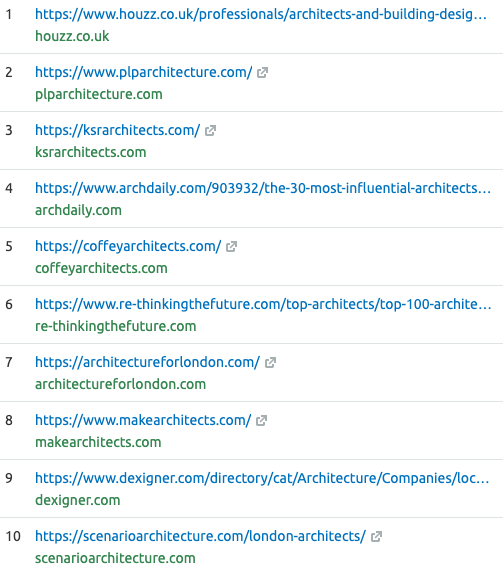
This is a huge result for the firm as it gives them ample traffic and thousands of potential leads.
Overall, their homepage receives an average of 4,500 monthly views. Which is 56.9% of their total website traffic.

With over 1,300 monthly searches for “architects in London”, all of these searchers land directly on PLP Architecture’s homepage.
As such, PLP Architecture also ranks highly for variations of the keywords “architects in London”, including:
- “architecture firms in London” (top 3)
- “architecture practices London” (top 3)
- “architects central London” (no 1)
This isn’t by accident.
In fact, the term ‘architect’ is mentioned 27 times on their homepage. And the term ‘London’ is mentioned 10 times.
Now, we are not advocating keyword stuffing at all. In fact, we often tell businesses to avoid it as it doesn’t enhance your SEO. Because doing so could stop you from ranking entirely. However, let’s compare these keyword numbers to Hawkins\Brown. This firm’s homepage has the keyword ‘architects’ appear 6 times and ‘London’ 3 times.
Which one do you think is most likely to appear in search ranks for ‘architects London’?
It won’t surprise you to know that Hawkins\Brown is ranked at number 23 and on page 3 on Google.
Imagine where Hawkins\Brown could rank if they mentioned the term ‘London’ and ‘architects’ on their homepage just a bit more.
Obviously, we are oversimplifying on-page SEO here to make a point. But if you were looking to try and rank highly for ‘architects in London’, then you have to start from the premise that you need to be using these keywords on your page.
It may sound obvious But you would be amazed how often we speak to clients that haven’t considered this. In fact, some build entire websites without a single mention of the words they want to rank for.
Lesson 2 - Create specific landing pages which nail important long-tail keywords

Your architecture firm’s location and area of expertise will be dependent on the keywords you aim to rank highly for.
It is easier to rank well for a longtail keyword that is less competitive. Rather than trying to go for a really short-tailed one straight from the bat.
For example, ‘architects in London’ is a long-tailed keyword and ‘architects’ is a short-tailed keyword. So it will be easier to rank for ‘architects in London’ compared to just ‘architects’.
Apply this same logic for your own business. So if you are a conservation architect, then own that term because:
- It will be easier to rank for a less competitive term
- Your content is likely more relevant for the searcher, which will increase conversion
- It is easier to find your own voice, the more specialised you become
In summary, you should think about or consider creating specific pages or content that aims to rank for different keywords. Such as office locations or specialist areas.
For example, you could create a page for each of your offices. Then work towards getting each office page ranked highly for their location within your specialist area.
To do this ensure you use relevant keywords within your specific pages.
An example not to copy is Gensler. Whilst they do have location pages (good), they don’t have much copy on these pages (bad).
They have a separate landing page for each one of their 50 offices. But each location page only contains the office address, a map, and links to different content within that location.
No actual written content at all.
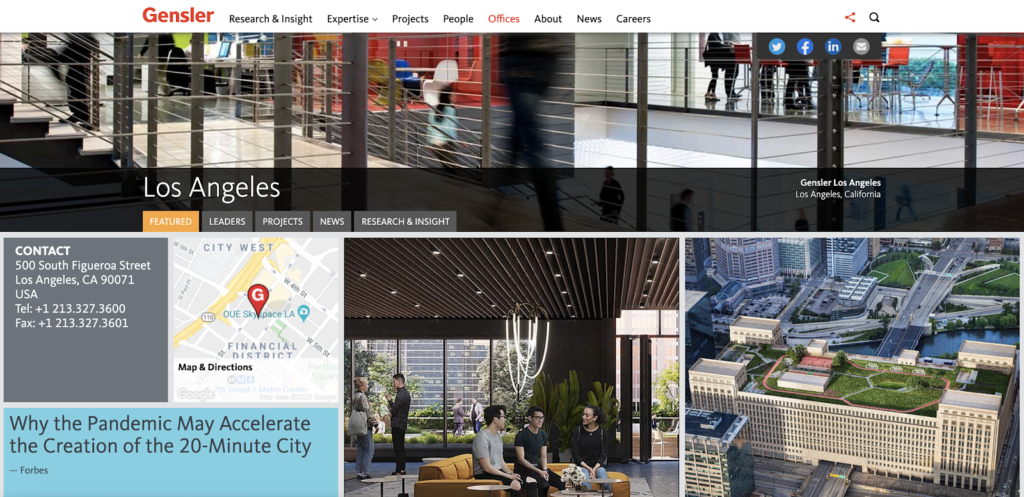
As a result, these offices don’t rank highly for keywords… which they easily could.
For example, take a look at how low they rank for keywords such as ‘Los Angeles architecture offices’. These long-tail keywords would bring them ample traffic if they added more content onto their office pages.
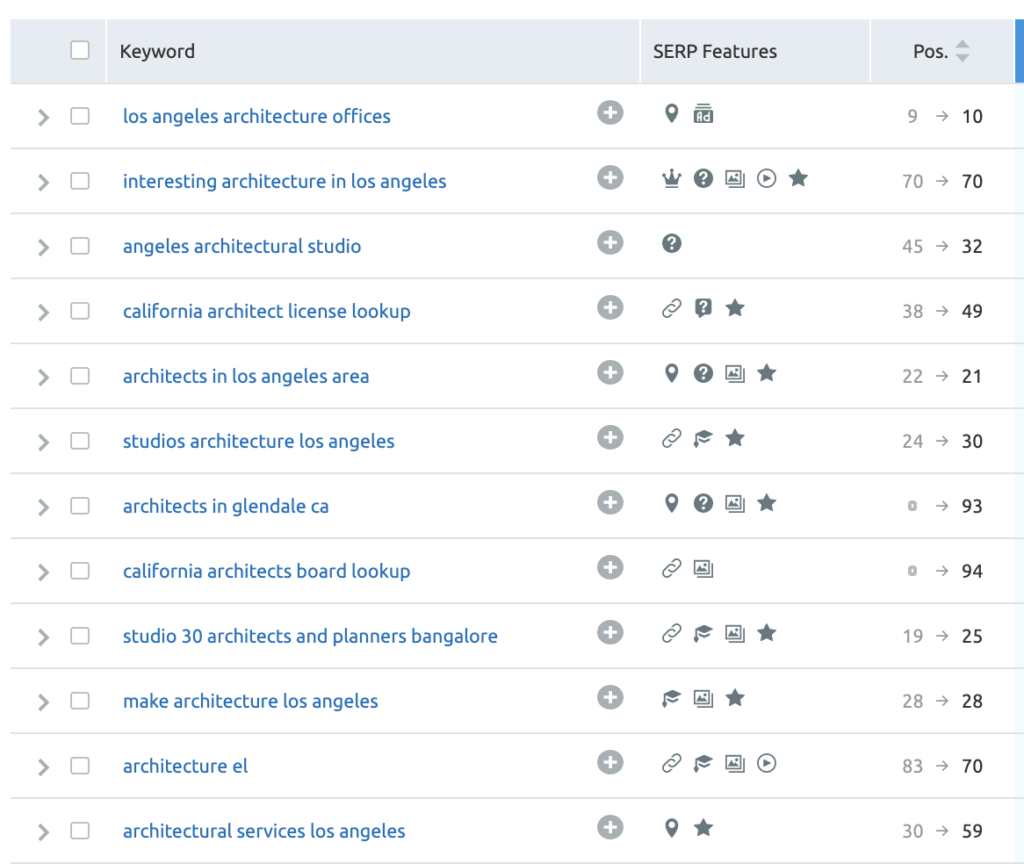
As such, Gensler is missing out on huge amounts of traffic. And they could be ranking on the first page in Google for these keywords.
In fact, the word architect is only featured once on the entire page in the title within one of their other links.
Remember, once you have decided on a keyword you should conduct research into what is already out there. Look at what is already ranking at number one and try to work out how to make a better piece of content.
But be aware that ranking for keywords takes more SEO factors into consideration. So make sure you don’t keyword stuff or fall into easily avoidable backlinking and SEO pitfalls.
Lesson 3 - It Is Not All About Services Landing Pages
Content marketing comes in many shapes and sizes. From landing pages and videos, to blog articles and infographics. Each piece of content has a different purpose.
While it is good to create landing pages that contain information about what services you provide. As well as information about your services or employees. This doesn’t have to be your only content.
Not only do people search for keywords but they also search for answers to questions.
You can create content around questions, specific concerns, FAQs, issues, and common misconceptions.
Creating content around answers to questions will allow you to gain traffic for key phrases associated with your keyword area.
Grimshaw Architects have created content around their completed buildings. Anyone who wants to find out any information about one of their buildings can do so.
For example, they have created a project page on their work on the Fulton Center in New York.
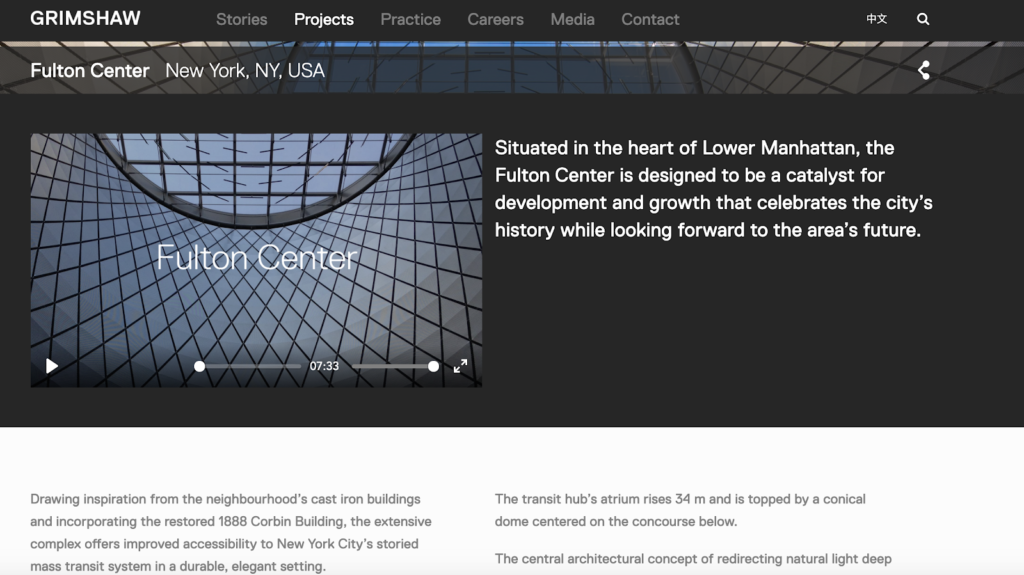
This project page is ranked number 4 in Google’s search results for Fulton Center. Which has a search volume of 1,900 searches a month. So for anyone searching for the Fulton Center, they will see this project page on the first page of Google.
By being here they will obtain traffic from people interested in the building. In addition to traffic from people looking for the architects who built the Fulton Center. As well as backlinks from people wanting to talk about the Fulton Centre and link back to an authoritative source.
So, depending on what type of architecture your firm specialises in, you could create relevant content on completed projects.
You could create content rich with images, outlining basic project information such as how you undertook the designing process. Or you could upload sketches and write facts about the projects. Basically, whatever you like.
In addition, you could also create content around questions you think your potential clients might ask. Think about what they might search for in Google.
For instance, you could include FAQs along the lines of:
- Potential challenges with a job
- Information about the services you require
- Your design process
- What sets your firm apart from others
- Your payment process
- Trending design projects
- Guides to building a new home
Overall, you should use your blog to expand and create content around your service pages.
Lesson 4 - You Need to Create Content

One of the key ways to be successful with your content marketing strategy is to create a variety of high-quality content.
This content should also be published consistently. Producing one press release every 6 months or one new blog article a month isn’t going to cut it. It’s unlikely to provide long term growth and will quickly fall into obscurity in search results pages.
More importantly, if you’re targeting first place on Google, then you need to put out better content than your competitors.
Let’s look at ERP Architects, they have lots of content on their website including:
- Press releases
- Projects
- Campaigns
- A Sketchbook
- Publications
They produce between 3 and 5 press releases a month. Of course, this is depending on if they have completed a project. Or have done something worth an extra press release. They do this regularly in addition to their other content.
In fact, if you look at these ten firms – here is how often they post content on their websites:
- Zaha Hadid Architects publishes an average of 6 news articles a month
- Grimshaw produces one press release per month and an average of 3 news articles
- Foster and Partners produces 3 news articles per month and adds any new projects they may have
- Gensler produces an average of 15 blog articles per month in addition to press releases (when required), surveys, projects, videos, and other content
- 10 Design publishes between 2 and 6 press releases a month
- 3D Reid publishes an average of 2 press releases a month
- 5 Plus Architects produces between 1 and 3 press releases a month
- ADAM Architecture creates an average of 4 news articles a month
- ADP Architecture publishes an average of 3 news and insights articles a month
- David Chipperfield Architects publishes an average of 4 news articles each month with some months up to 7
So in summary, consistently published content produced in a variety of different forms will help people recognise your company is still active and producing content.
Ideally, depending on the aims of your content marketing, you should be publishing a number of articles or different pieces of content a month. An overall standard when beginning to create blog posts or content depends on the size of your firm.
A benchmark for content for a smaller firm is posting new content 3 or 4 times a week to help increase traffic.
For a larger firm 4 or 5 times, a week would be more suitable. Of course, this depends on the amount of time available to produce new blogs or update existing blogs.
And don’t forget to promote your content efforts with social media, PR, outreach and email marketing too.
Lesson 5 - Consistency Over Time
Content takes time to create. But high-quality content will be well worth all the time and effort.
The results from content marketing take time to show too. With growth happening over months rather than weeks.
For example, Foster and Partners have a section on their website where they showcase completed projects.
One of the projects they have worked on is Apple Park.
On this project page, they give detailed information about the project. Such as where it is located, an image gallery, the local area, facts, and the team involved.
This page was first ranked in Google for the keyword “apple headquarters” in December 2019. It sat at position 12 in Google’s search results.
By November 2020, the page was ranked at number 8. Great for a keyword with 33,100 monthly searches!
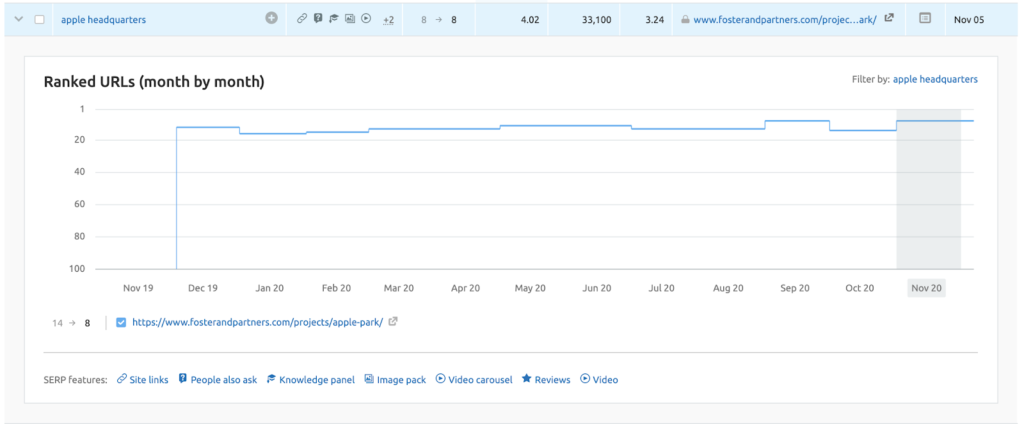
Thus, it took a year to slowly increase its ranking.
This one single page also ranks for an additional 162 keywords. In this time it has also received 34 backlinks from 22 referring domains. These links are vital for their overall organic growth.
Foster and Partners have been regularly creating content since before January 2012. And this has well and truly paid off. As it stands, they now have just under 40,000 keywords ranking in Google across 932 pages.
This is giving them annual monthly traffic of 114,700 and a DA of 63. As well as 350,300 backlinks from 12,700 referring domains.
Content marketing is a long-term strategy and you should view it as such. Simply creating content for a bit and giving up isn’t going to work.
It might take you a year or more to gain a high ranking in Google. But it will be worth it in the end.
It takes a month or sometimes longer for your article or piece of content to first rank in search results. So don’t be disheartened if you don’t get instant results.
It is also important to constantly update and refresh your content to ensure it stays relevant.
Factor in regular content marketing to ensure you get the long-term growth that your firm deserves.
Lesson 6 - Quality is Important

It isn’t good enough to just to create content, the quality of the content is extremely important too.
Publish the best possible content you can.
Each piece of content is a representation of your brand and company.
And if you don’t create great content that you are proud of, ultimately, what’s the point? Why would anyone else want to read, post or link to your content?
Here are two examples of content marketing to labour this point:
First is a piece of content by Foster and Partners. They have produced a press release titled: “Apple Marina Bay Sands – A New Gemstone on the Singapore Waterfront and a Celebration of Light”. This press release features an image, text, a link to the speech, and the ability to download the file as a pdf.
Overall, this piece of content ranks for 10 keywords and has 2 backlinks from 2 referring domains.
The second piece of content is from Farrells entitled: “Farrells Has Been Appointed for the Expansion of the Hong Kong Science Museum and Hong Kong Museum of History”.
This press release contains a huge image with graphics. But it only has 57 words. Yes, it’s straight to the point and simple. However, it doesn’t really bring anything to the website.
And surprise, surprise, no one links to it.
Ask yourself, which company would you be attracted to based on their content? Which company would you trust to do the best job?
Having detailed content which ranks highly and contains high-quality detailed information is important. As such, it should be more informative and definitely more than 100 words.
In 2020, the ideal number of words for a high ranking blog post is between 2,100 and 2,400 words.
Obviously, this depends on what type of content you are producing. For example, for a press release, the ideal length is between 300 and 500 words.
The key lesson here is that when you are creating content, think about the following:
- What is the aim of this piece of content? Why am I creating it?
- Who is my target audience?
- Research who currently ranks at number one for the keywords you are using
- Have I considered all SEO ranking factors?
- Does this piece of content address my aims?
- Is this the best piece of content I can possibly create?
Once you have considered all of these factors. Then produced the best piece of content you possibly can. Only then is it time to publish it.
Lesson 7 - Have a Personality

The best content has a personality, an individual tone and style of writing. It’s what makes your brand or firm different to everyone else.
Your words reflect who you are as a company.
People will identify and build a trusting relationship with your company when they read your words. As a result, they will then decide what your company represents.
So, work out who you are, how you want to sound and convey that in your content.
Haven’t worked out your personality yet? Then take it from a different angle. Decide who you are not, or how you don’t want to sound and work from that point instead.
Consider these points to help you create a personality for your firm:
- Be real, be transparent, be a real-life person. Ultimately, show that there is someone behind the firm and content you create
- Put across your point of view. Decide if you want your content to be persuasive, informative, or to be a point of discussion
- Incorporate your emotions into your content. You can decide what emotions you want people to feel when they are reading your content
- Use your content to tell a story to make it interesting
- Define your behaviours and interactions with the public on social media. Consider how you get your brand’s voice across
- Incorporate your language into your content
- Create a structure to your content. For example, each blog post will have an introduction, main text, and then summary
- Be consistent with your content layout, designs, graphics, and brand image
By considering all these points your content will convey your brand and personality to all your viewers.
Lesson 8 - Think About Your Audience

In our list of content lessons for architecture firms, this one could be considered most important. After all, it’s your audience and what they say about your firm that wins you paying clients. That’s why it’s important to undertsand them.
When you are creating your content you have to decide how best to speak to your audience. In addition, you need to identify what your audience is looking for.
Think about how you would talk to a huge multinational corporation looking for an architect for a skyscraper for example.
Then think about how you would talk to a homeowner who requires trust and a relationship before they permit you to design their home or extension.
In these two examples, the tone of your content would be different. So would how you promote your content?
Example 1: A local architect could conduct a Google search for “architects in London” for example. So ranking for that keyword would be vital. Whereas a big business looking for an architect might be more interested in a firm’s previous projects as reviews.
Howie Architects have created multiple blogs on their site. And one of these blogs is called “Five Reasons to Use an Architect”.
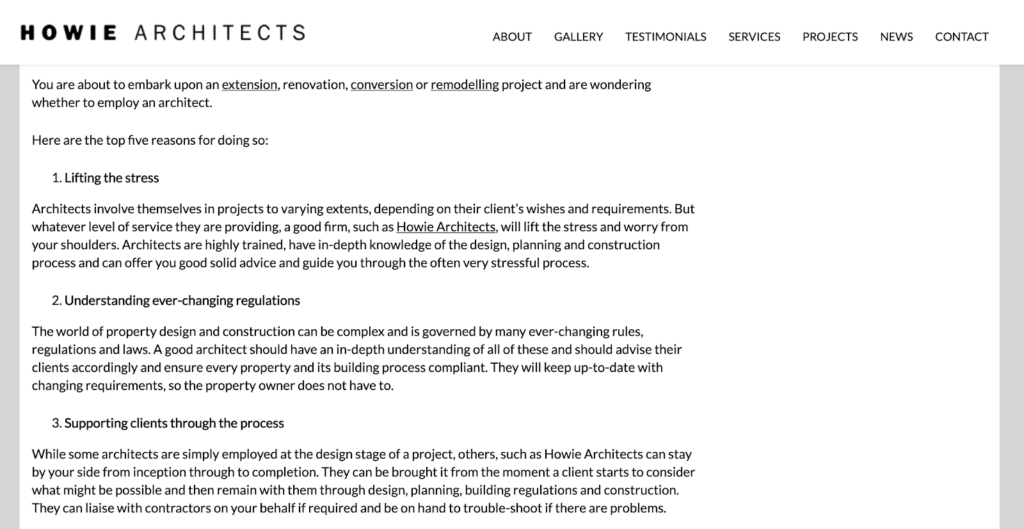
Here you can see their article is based around home remodelling, extensions, and renovations.
Their tone is also appropriate for their audience too, as they are speaking to homeowners.
Example 2: Another firm called Grimshaw has very different clients. With previous projects including Shanghai Disney Resort Tomorrowland.
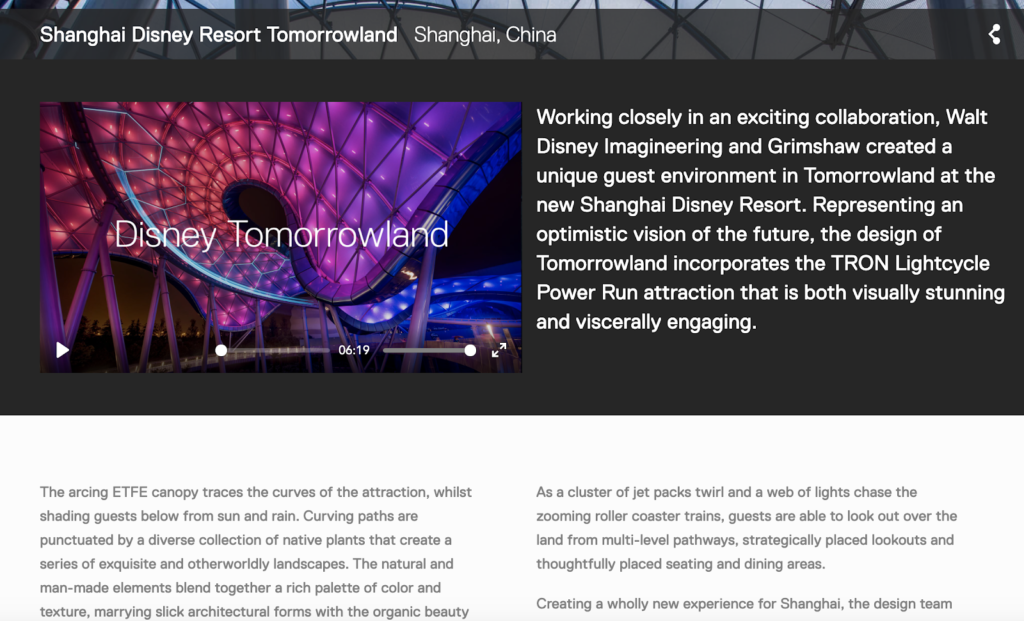
As such, they have a very specific tone. It’s more formal and they are much more corporate in their language.
Overall, the two pieces of content are very different in terms of target audience and tone.
The key point is to think about your content from this perspective and write for your audience.
In short, the more specialised you are for your audience, the better.
After all, you would rather have 2 perfect customers than 50 customers that aren’t looking for your services.
Quality over quantity.
Lesson 9 - Promote Your Business Effectively
Great high-quality content is crucial for successful content marketing. But promotion is equally as important.
You can produce the best piece of content in your industry. However, if no one sees it, who cares?
One of the best ways to promote content is through social media channels.
LinkedIn is a great way to promote professional content. But this may only be relevant if you are targeting that specific audience. For example, a small, local architect might find Instagram works better for their audience.
That being said, lots of architecture firms use LinkedIn to showcase and promote website content, articles, journals, and videos. It is a great way to repurpose content.
An example of a firm using social media to promote their content is Zaha Hadid Architects. They are a worldwide name and as such have over 417,000 followers on LinkedIn.

Content on social media such as this video is a great way to gain brand awareness and showcase the company. This video has been seen by over 71,000 viewers.
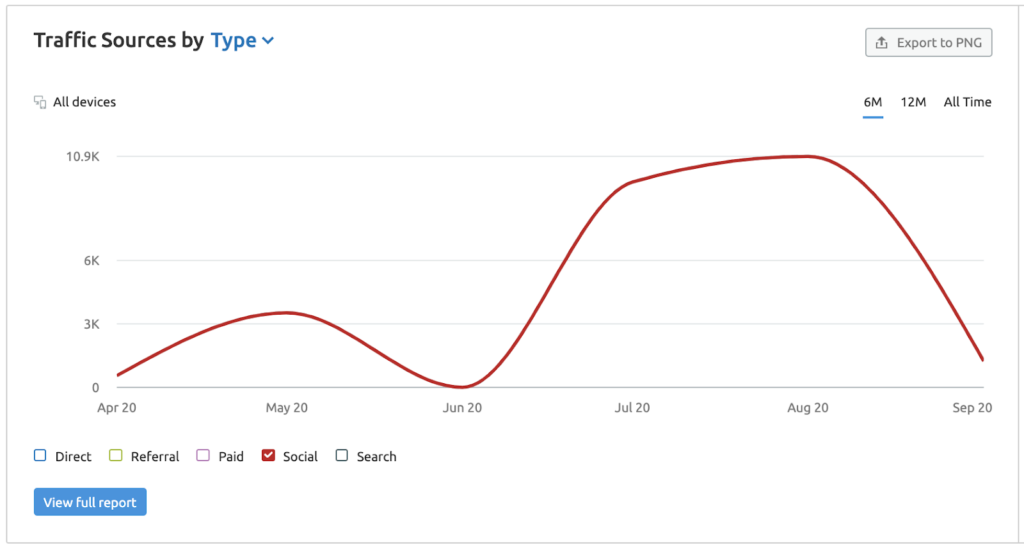
Social media can be a great way of gaining traffic to your website through links and posts too. Some ideas of things you could share on social media could be:
- Links to blog articles
- Links to press releases or news articles
- Video content of a completed project
- Video content of employees talking about FAQs
- Details of a completed or ongoing project
- Images of previous projects or sketches
Benchmarks or frequency and ideal times to post on social media vary by industry. But the average for an architecture firm to post on social media is as follows:
- Facebook – 90 posts per month
- Instagram – 62 posts per month
- Twitter – 105 tweets per month
- LinkedIn – 34 posts per month
While you might think these numbers are high, they are just an idea and are based on your leading competitors.
Obviously, how often you should post will highly depend on your firm’s ability to. As well as your overall content marketing strategy.
Much like lesson 5, social media is about consistency too. Don’t just create pages and leave them, as nothing will happen, unsurprisingly.
Lesson 10 - Make Use of Your Completed Projects by Turning Them Into Content
A great way to start or enhance your content marketing journey is by utilising previous content. For example, you may have already created assets for your client’s projects. Or you could alter work projects and publish them online.
One great way to do this is by using your website as an online design portfolio. You can use your existing content such as images or information about your projects.
For example, Foster and Partners have put their portfolio online in their “Projects” section of their website. They have sections for different types of projects, completed projects, and those under construction.
This area has a different page for each project. An example of one of these pages is “Magdi Yacoub Global Heart Center Cairo”. This page is located in the section “under construction”, where it details images of what the building will look like, relevant information, images of the current construction, and facts.
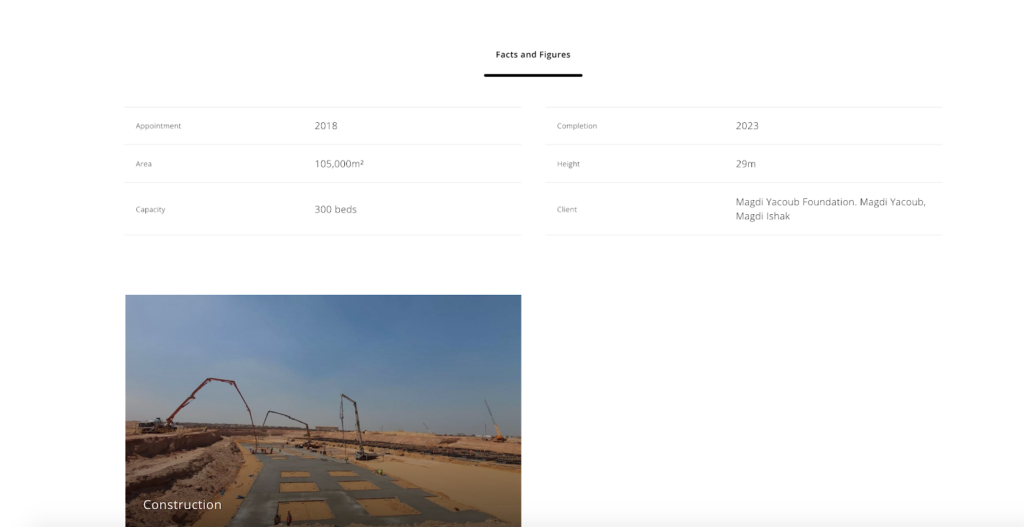
Other projects and pages of completed buildings have a concept and final images, videos, and press releases.
Images of different stages of the projects, a completed video walkthrough, an explanation of the whole process. These and any other information you might have would be great things to showcase.
This content is a great way to rank for keywords (including the building name). So anyone searching for information about the project can find it easily.
Lesson 11 - Create a Mailing List

This content lesson for architecture firms is one you may not have thought of initially, but consider your own email.
You may have signed-up to mailing lists in the past few years. From shops to high street brands, news publications, and more.
Mailing lists are an excellent way to communicate with clients or potential clients.
At first, you might not see why architecture firms need a mailing list. But it’s just as important to have one as it is to have any other form of content marketing.
When an architecture firm has a mailing list they can use it to communicate with existing or potential clients. This is in order to send them newsletters, company updates, or useful information. Doing so, helps to create and foster a relationship between the firm and its clients.
If you receive regular email updates you are constantly being exposed to the firm. This familiarity will help the firm to build a trusting relationship with you.
For example, Ryder Architecture has a sign-up form on its homepage.
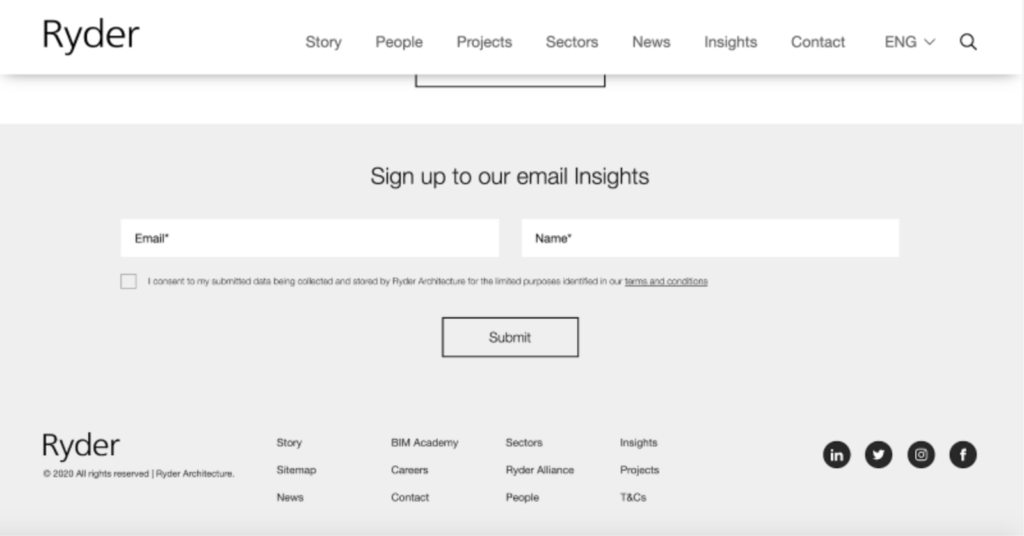
Ryder Architecture receives 73.7% of its total traffic to its homepage which is 1,600 monthly views. All of these visitors have the opportunity to sign-up to their mailing list.

Newsletters also help to send referral traffic to the firm’s website.
Email marketing has played its part in Ryder Architecture’s increase in traffic. They now have 2,400 monthly viewers and domain authority (DA) of 38.
As such, your firm could easily include a sign-up form on your homepage to start collecting potential clients email addresses.
You could then send out bi-weekly newsletters with information about your firm, new projects, or any links to recently published articles.
Emails from architecture services have an average open rate of 23.31% and an average click-through rate of 2.94%. This is higher than the average open rate for all industries.
Therefore, make sure you plan for email marketing as a key cornerstone of your content marketing efforts.
The more data you have, the more you are able to communicate with your audience. As a result, the more likely it is that people will come to you when they are interested in your services.
Lesson 12 - Create Engaging Videos
Content in the form of videos rather than text is gaining more and more popularity. Over 72% of people would rather watch a video than reading text.
Video content creates the opportunity to engage with viewers, answer questions, post video reviews of your firm, showcase walkthroughs of buildings, and more.
Architecture firm Hawkins\Brown has a video posted at the top of their homepage. This video was filmed in their office. And it involves their employees holding up signs with writing on them. Each sign showcases information about the company.
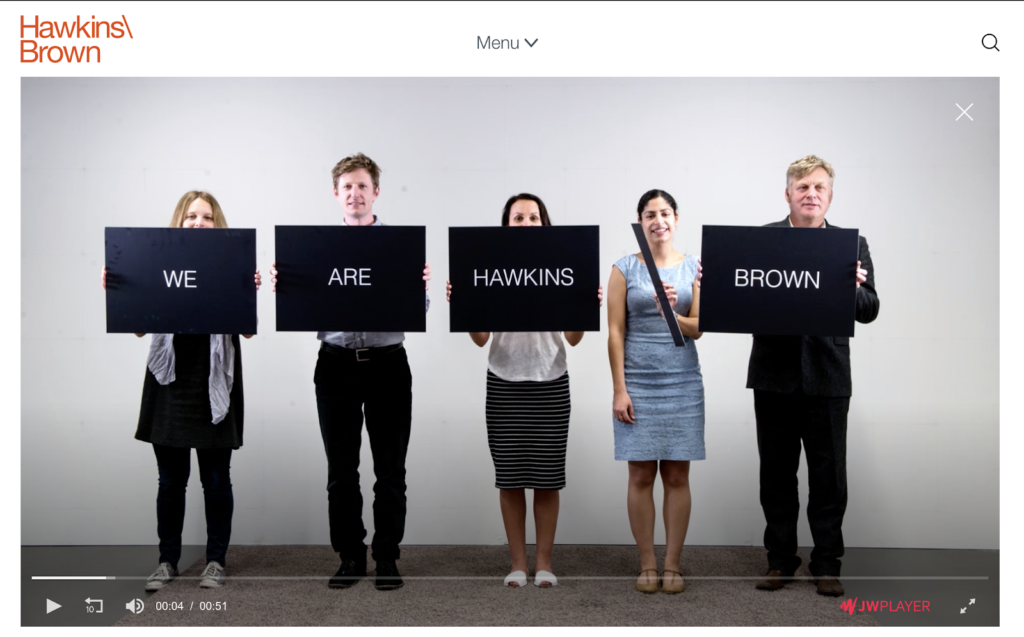
Another example of using video content to showcase designs is from Zaha Hadid Architects.
They have created and published a video which is a walkthrough of a recently completed project. It was an ambitious project which they undertook for the Beijing Daxing International Airport.
Videos like these help to humanise the brand, highlight expertise and showcase the employees behind the name.
You could create video content on anyone of the following:
- FAQs, expert advice or knowledge from an employee
- A walkthrough of a completed project
- The design process
- Information about the firm or its history
- Live Q&A video on social media
- Webinars with interactive Q&As
- Video reviews from previous clients
Creating video content does take time and effort to produce, but it is well worth it.
Once you create video content you can repurpose it for other content too. Such as product videos, promo videos, social media stories or videos, and other general purposes.
Lesson 13 - Prioritise Outreach and Backlinking
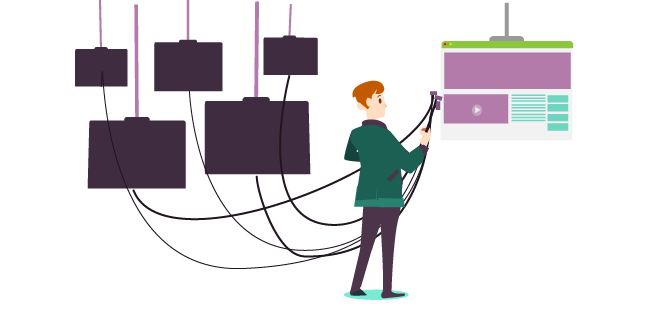
One of the top factors Google takes into consideration when ranking search engine results is backlinks. That’s why backlinks made our content lessons for architecture firms.
A backlink to a website is seen by Google as a sign of value. It infers that the content contains something credible and is valuable enough that someone would want to share it.
Architecture firms are no different, backlinks are equally as important to them as any other business.
Backlinks can be gained in a large number of ways. Two examples of ways in which architecture firms are gaining backlinks are through guest blogging and press releases.
The architecture firm Pride Road has been gaining backlinks through guest blogging. One of the founders has written multiple guest blogs across various publications. Such as in journals, on websites, and for architecture magazines.
An example of a great backlink Pride Road has received is from Architects Journal. This backlink has gained them plenty of credibility. Architects Journal has a DA of 62, which is a great backlink for the firm to receive.

This backlink, along with the other 2,900 backlinks they have received from 278 referring domains, has increased their DA.
Another example of a great backlink for an architecture firm is Grimshaw, who have been using press releases to gain backlinks.
Grimshaw has been regularly publishing press releases on its website. As a result, they have been picked up by news publications.
An example of a backlink they have gained is from Global Construction Review, which has a DA of 56.
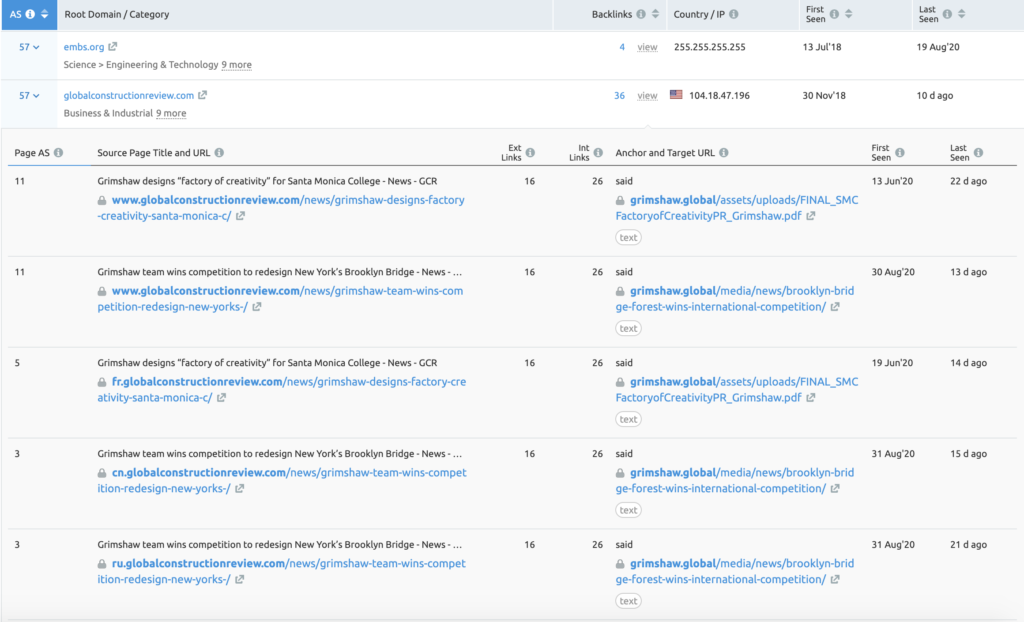
The firm has another 23,500 backlinks from 1,500 referring domains. Some of these 1,500 referring domains are:
- Yahoo – DA 91
- BBC – DA 88
- The Guardian – DA 87
- NY times – DA 87
- Harvard.edu – DA 86
- Forbes – DA 85
- Telegraph – DA 83
Overall, these backlinks have helped Grimshaw’s website gain a DA of 47.
Backlinks help increase a website’s DA. They also ensure each company receives a higher ranking for keywords over lower DA competitors in Google.
Here are some backlinking strategies you can use:
- Create high-quality content which is above industry standard and gains its own backlinks
- Reach out to an architecture journal or website which allows guest blogs and pitch your article to them
- Find a broken link on a website and offer one of your articles as a replacement
- By creating infographics
- Writing best-list blog articles
- By creating and distributing press releases
- Utilising directories in your local area
- Forum links
Make sure your content marketing also factors in ways to gain backlinks too. That way, you are maximising your content from an off-page SEO perspective too.
Lesson 14 - Collect Reviews and Social Proof
Our final content lesson for architecture firms is about the power of reviews.
Many people turn to friends and family for services or company recommendations.
But websites have taken this whole process of reviews online. With many firms showcasing reviews and testimonials from previous clients.
Examples include showcasing images and videos of completed projects. As well as video testimonials of previous clients talking about their experiences with the firm.
These testimonials help to build trust with the brand which is an important factor for any business. With trust, people will become loyal to your company or service.

Howie Architects have a section on their homepage where they post online reviews written by previous clients. This means site visitors can easily see these reviews as soon as they visit their homepage.
You can reach out to a previous customer and ask them to send you a review of what it was like working with you. Or you could ask clients immediately upon completion of your project.
Then you can create articles or testimonials and other forms of content from these reviews.
Overall, these reviews will help enhance the firm’s brand and create social proof.
People want to use a firm or company they can trust to do the job professionally and correctly. And social proof such as reviews, allows you to help them make that decision.
Summary
These 14 content lessons architecture firms are just a starting point of the things your architecture firm can do and achieve with content marketing.
Content marketing provides ample room for growth and increased traffic. Especially when it comes to using different forms of content marketing. It can help turn your firm into a brand that is well known. One recognised for providing a great service and creating a trusting brand.
So, take these 14 content lessons for architecture firms, and start plotting your own content marketing success.
You Can Work With a Marketing Consultancy to Put These 14 Lessons into Practice
Many firms turn to a market consultancy like ours, to help them grow online through content marketing.
We also conduct website analysis and competitor analysis reports. These can advise you on the best strategies required to help you achieve your goals online.
So why not contact us today for an obligation-free chat? Get in contact today and you can find out exactly what we can do to take your firm to the next level.







